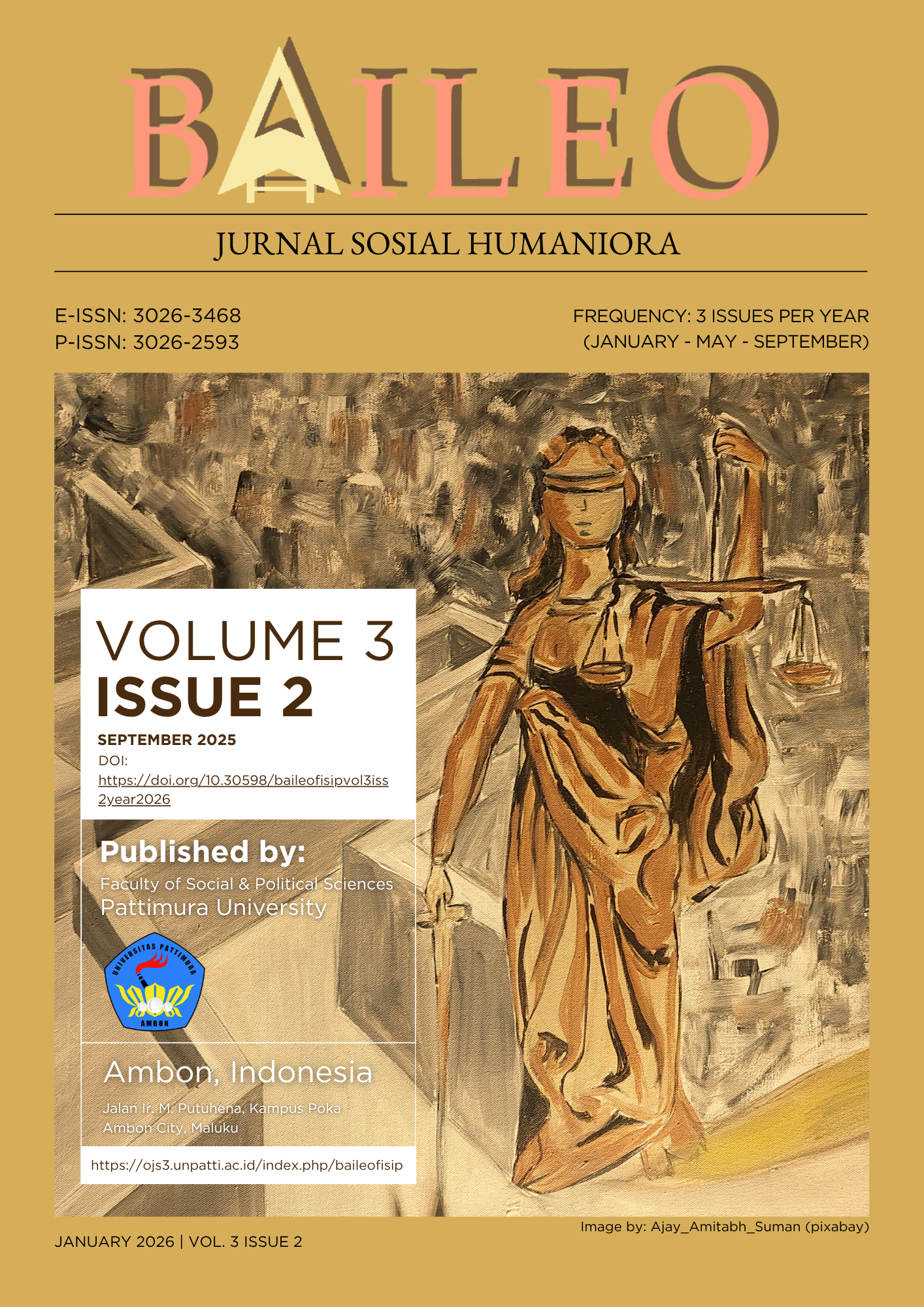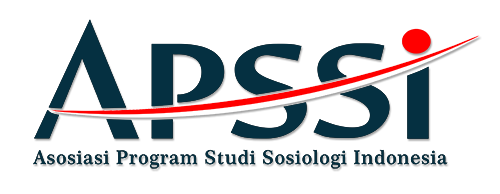Synergizing Safe Behaviour, Safety Leadership, and Safety Communication: A Sociological Analysis of Safety Culture Formation and Operational Excellence in High-Risk Industries
Abstract
This study investigates the sociological dynamics shaping the formation of safety culture and its role in achieving operational excellence within high-risk industries. Despite widespread adoption of safety policies, organizations in Indonesia’s oleochemical sector remain limited by compliance-based practices that neglect the social, cultural, and communicative dimensions of workplace safety. Adopting a post-positivist paradigm and a sequential explanatory mixed-methods design, the research integrates quantitative analysis using Structural Equation Modeling (SEM-Lisrel) of 421 employee responses with qualitative thematic analysis through MAXQDA. The results reveal that safe behaviour, safety leadership, and safety communication jointly explain 87.2% of the variance in safety culture and 91.3% in operational excellence, with safety communication emerging as the strongest determinant linking policy to practice. Qualitative findings highlight safety as a socially constructed system grounded in trust, dialogue, and shared meaning, reinforced through practices such as Gemba Walks, Safety Talks, and Toolbox Meetings. The study’s novelty lies in its integrative sociological framework that unites behavioural, leadership, and communication dimensions of safety culture, traditionally treated separately, within a social systems perspective. Theoretically, it advances organizational and industrial sociology by conceptualizing safety culture as a dynamic interplay of structure, agency, and communication, offering both analytical depth and practical insight for sustainable safety management.
Downloads
References
Baedke, J., Fábregas-Tejeda, A., & Prieto, G. I. (2021). Unknotting reciprocal causation between organism and environment. Biology & Philosophy, 36(5), 48–60. https://doi.org/10.1007/s10539-021-09815-0
Bidwell, L. N., & Báez, J. C. (2025). Mixed methods research. In Handbook of Research Methods in Social Work (pp. 197–209). Edward Elgar Publishing. https://doi.org/10.4337/9781035310173.00026
Bisbey, T. M., Kilcullen, M. P., Thomas, E. J., Ottosen, M. J., Tsao, K., & Salas, E. (2021). Safety Culture: An Integration of Existing Models and a Framework for Understanding Its Development. Human Factors: The Journal of the Human Factors and Ergonomics Society, 63(1), 88–110. https://doi.org/10.1177/0018720819868878
Bria, T. A., Chen, W. T., Muhammad, M., & Rantelembang, M. B. (2024). Analysis of Fatal Construction Accidents in Indonesia, A Case Study. Buildings, 14(4), 1010. https://doi.org/10.3390/buildings14041010
Carvalho, A. M., Sampaio, P., Rebentisch, E., Carvalho, J. Á., & Saraiva, P. (2021). The influence of operational excellence on the culture and agility of organizations: evidence from industry. International Journal of Quality & Reliability Management, 38(7), 1520–1549. https://doi.org/10.1108/IJQRM-07-2020-0248
Cavazotte, F., Mansur, J., & Moreno, V. (2021). Authentic leadership and sustainable operations: How leader morality and selflessness can foster frontline safety performance. Journal of Cleaner Production, 313(1), 127819. https://doi.org/10.1016/j.jclepro.2021.127819
Chiarini, A., & Kumar, M. (2021). Lean Six Sigma and Industry 4.0 integration for Operational Excellence: evidence from Italian manufacturing companies. Production Planning & Control, 32(13), 1084–1101. https://doi.org/10.1080/09537287.2020.1784485
Dyreborg, J., Lipscomb, H. J., Nielsen, K., Törner, M., Rasmussen, K., Frydendall, K. B., Bay, H., Gensby, U., Bengtsen, E., Guldenmund, F., & Kines, P. (2022). Safety interventions for the prevention of accidents at work: A systematic review. Campbell Systematic Reviews, 18(2), 12–34. https://doi.org/10.1002/cl2.1234
Faccio, M., Granata, I., Menini, A., Milanese, M., Rossato, C., Bottin, M., Minto, R., Pluchino, P., Gamberini, L., Boschetti, G., & Rosati, G. (2023). Human factors in cobot era: a review of modern production systems features. Journal of Intelligent Manufacturing, 34(1), 85–106. https://doi.org/10.1007/s10845-022-01953-w
Febrira, S., Iskandarini, I., & Siahaan, E. (2025). Leadership as a Social Catalyst: Moderating the Relationship Between Talent Management and Job Satisfaction in Strategic Industries. Baileo: Jurnal Sosial Humaniora, 3(1), 171–193. https://doi.org/10.30598/baileofisipvol3iss1pp171-193
Gabriella, R., & Rengkung, F. Z. (2025). Code-Switching as Social Identity Marker among Chinese-Indonesian Students in Urban Educational Settings. Jurnal Tahuri, 22(2), 157–177. https://doi.org/10.30598/tahurivol22issue2page157-177
Hirose, M., & Creswell, J. W. (2023). Applying Core Quality Criteria of Mixed Methods Research to an Empirical Study. Journal of Mixed Methods Research, 17(1), 12–28. https://doi.org/10.1177/15586898221086346
Jackson, A., Godwin, A., Bartholomew, S., & Mentzer, N. (2022). Learning from failure: A systematized review. International Journal of Technology and Design Education, 32(3), 1853–1873. https://doi.org/10.1007/s10798-021-09661-x
Jankelová, N., & Joniaková, Z. (2021). Communication Skills and Transformational Leadership Style of First-Line Nurse Managers in Relation to Job Satisfaction of Nurses and Moderators of This Relationship. Healthcare, 9(3), 346. https://doi.org/10.3390/healthcare9030346
Kakemam, E., Gharaee, H., Rajabi, M. R., Nadernejad, M., Khakdel, Z., Raeissi, P., & Kalhor, R. (2021). Nurses’ perception of patient safety culture and its relationship with adverse events: a national questionnaire survey in Iran. BMC Nursing, 20(1), 60. https://doi.org/10.1186/s12912-021-00571-w
Khalid, U., Sagoo, A., & Benachir, M. (2021). Safety Management System (SMS) framework development – Mitigating the critical safety factors affecting Health and Safety performance in construction projects. Safety Science, 143(12), 105402. https://doi.org/10.1016/j.ssci.2021.105402
Kou, Y., & Liu, K. (2025). Effects of dual organizational network embeddedness on safety resilience in construction projects. Engineering, Construction and Architectural Management, 11(1), 1567. https://doi.org/10.1108/ECAM-11-2024-1567
Kurnianto, A. A., Khatatbeh, H., Prémusz, V., Nemeskéri, Z., & Ágoston, I. (2023). Managing disabled workers due to occupational accidents in Indonesia: a case study on return to work program. BMC Public Health, 23(1), 943. https://doi.org/10.1186/s12889-023-15930-2
Lameijer, B. A., Pereira, W., & Antony, J. (2021). The implementation of Lean Six Sigma for operational excellence in digital emerging technology companies. Journal of Manufacturing Technology Management, 32(9), 260–284. https://doi.org/10.1108/JMTM-09-2020-0373
Leko, M. M., Hitchcock, J. H., Love, H. R., Houchins, D. E., & Conroy, M. A. (2023). Quality Indicators for Mixed-Methods Research in Special Education. Exceptional Children, 89(4), 432–448. https://doi.org/10.1177/00144029221141031
Liu, C., Ahmad, N., Jiang, M., & Zulqarnain Arshad, M. (2024). Steering the path to safer food: The role of transformational leadership in food services to combat against foodborne illness. Journal of Retailing and Consumer Services, 81(2), 103958. https://doi.org/10.1016/j.jretconser.2024.103958
Macrae, C. (2022). Learning from the Failure of Autonomous and Intelligent Systems: Accidents, Safety, and Sociotechnical Sources of Risk. Risk Analysis, 42(9), 1999–2025. https://doi.org/10.1111/risa.13850
Marques, L., & Manzanares, M. D. (2022). Towards social network metrics for supply network circularity. International Journal of Operations & Production Management, 43(4), 595–618. https://doi.org/10.1108/IJOPM-02-2022-0139
Mayer, M. (2023). Trusting machine intelligence: artificial intelligence and human-autonomy teaming in military operations. Defense & Security Analysis, 39(4), 521–538. https://doi.org/10.1080/14751798.2023.2264070
McDermott, O., Antony, J., & Douglas, J. (2021). Exploring the use of operational excellence methodologies in the era of COVID-19: perspectives from leading academics and practitioners. The TQM Journal, 33(8), 1647–1665. https://doi.org/10.1108/TQM-01-2021-0016
Meng, Q., Liu, W., Li, Z., & Hu, X. (2021). Influencing Factors, Mechanism and Prevention of Construction Workers’ Unsafe Behaviors: A Systematic Literature Review. International Journal of Environmental Research and Public Health, 18(5), 2644. https://doi.org/10.3390/ijerph18052644
Mertens, D. M. (2024). Mixed Methods Research for Social Betterment and a More Just World. Journal of Mixed Methods Research, 18(3), 216–224. https://doi.org/10.1177/15586898241256834
Mincu, M. (2022). Why is school leadership key to transforming education? Structural and cultural assumptions for quality education in diverse contexts. PROSPECTS, 52(3–4), 231–242. https://doi.org/10.1007/s11125-022-09625-6
Mukumbang, F. C. (2023). Retroductive Theorizing: A Contribution of Critical Realism to Mixed Methods Research. Journal of Mixed Methods Research, 17(1), 93–114. https://doi.org/10.1177/15586898211049847
Nicolaidou, O., Dimopoulos, C., Varianou-Mikellidou, C., Boustras, G., & Mikellides, N. (2021). The use of weak signals in occupational safety and health: An investigation. Safety Science, 139(1), 105253. https://doi.org/10.1016/j.ssci.2021.105253
Noviyanti, L. W., Ahsan, A., & Sudartya, T. S. (2021). Exploring the Relationship between Nurses’ Communication Satisfaction and Patient Safety Culture. Journal of Public Health Research, 10(2), 2021–2225. https://doi.org/10.4081/jphr.2021.2225
Pattiasina, J. N., & Afdhal, A. (2022). Dari Bermain ke Praktik Sosial: Pembelajaran Role Play dan Pembentukan Kompetensi Komunikasi di Komunitas Pinggiran Indonesia. Populis: Jurnal Ilmu Sosial Dan Ilmu Politik, 17(1), 121–137. https://doi.org/10.30598/populis.17.1.121-137
Pollini, A., Callari, T. C., Tedeschi, A., Ruscio, D., Save, L., Chiarugi, F., & Guerri, D. (2022). Leveraging human factors in cybersecurity: an integrated methodological approach. Cognition, Technology & Work, 24(2), 371–390. https://doi.org/10.1007/s10111-021-00683-y
Proudfoot, K. (2023). Inductive/Deductive Hybrid Thematic Analysis in Mixed Methods Research. Journal of Mixed Methods Research, 17(3), 308–326. https://doi.org/10.1177/15586898221126816
Puspitasari, N., & Ayustia, R. (2024). Communication, Motivation, And Exemplarity: Building Performance Effectiveness Through A Family-Oriented Leadership Style. Baileo: Jurnal Sosial Humaniora, 2(2), 130–141. https://doi.org/10.30598/baileofisipvol2iss2pp130-141
Putri, D. L., Sumihardi, S., Irfan, A., & Djaja, I. M. (2019). Relationship between Unsafe Action and Condition with Work Accident among Production Unit Workers at The Jaya Sentrikon Indonesia Commpany, Padang, West Sumatra. Strengthening Hospital Competitiveness to Improve Patient Satisfaction and Better Health Outcomes, 22–30. https://doi.org/10.26911/the6thicph-FP.01.04
Qiu, Z., Liu, Q., Li, X., Zhang, J., & Zhang, Y. (2021). Construction and analysis of a coal mine accident causation network based on text mining. Process Safety and Environmental Protection, 153(2), 320–328. https://doi.org/10.1016/j.psep.2021.07.032
Ramadhan, G. A., Mustakim, D., & Zulfikar, A. J. (2025). The influence of organizational culture on the emergence of a blaming culture and its implications for workplace safety: A review article. TEKNOSAINS : Jurnal Sains, Teknologi Dan Informatika, 12(2), 322–328. https://doi.org/10.37373/tekno.v12i2.1596
Renn, O., Laubichler, M., Lucas, K., Kröger, W., Schanze, J., Scholz, R. W., & Schweizer, P. (2022). Systemic Risks from Different Perspectives. Risk Analysis, 42(9), 1902–1920. https://doi.org/10.1111/risa.13657
Rhaiem, K., & Amara, N. (2021). Learning from innovation failures: a systematic review of the literature and research agenda. Review of Managerial Science, 15(2), 189–234. https://doi.org/10.1007/s11846-019-00339-2
Sahoo, S. (2022). Lean practices and operational performance: the role of organizational culture. International Journal of Quality & Reliability Management, 39(2), 428–467. https://doi.org/10.1108/IJQRM-03-2020-0067
Saraswati, P., & Devi, A. (2023). Mixed Methods-Research Methodology an Overview. Nursing and Health Care, 5(4), 1–3. https://doi.org/10.30654/MJNH.100024
Shan, Y. (2022). Philosophical foundations of mixed methods research. Philosophy Compass, 17(1), 12804. https://doi.org/10.1111/phc3.12804
Siregar, W. R., Machfudiyanto, R. A., Prasetyo, B., & Suraji, A. (2024). Enhancing Safety Culture Among Subcontractors to Improve Safety Performance in the Indonesian Construction Industry. International Journal of Safety and Security Engineering, 14(6), 1913–1919. https://doi.org/10.18280/ijsse.140625
Sultan, M. (2023). Collaboration Tripartite Elements Accident Reporting and Potential Hazards Management Coal Mining, Indonesia: Systematic Review. Journal of Health Science and Medical Research, 41(6), 2023961. https://doi.org/10.31584/jhsmr.2023961
Vuong, B. N., Tushar, H., & Hossain, S. F. A. (2023). The effect of social support on job performance through organizational commitment and innovative work behavior: does innovative climate matter? Asia-Pacific Journal of Business Administration, 15(5), 832–854. https://doi.org/10.1108/APJBA-06-2021-0256
Wu, C., Yao, H., Ning, X., & Wang, L. (2021). Emergence of Informal Safety Leadership: A Social–Cognitive Process for Accident Prevention. Production and Operations Management, 30(11), 4288–4305. https://doi.org/10.1111/poms.13523
Yanuardi, Y., Vijge, M. J., & Biermann, F. (2022). Social‐ecological reflexivity of extractive industry governance? The case of the Extractive Industries Transparency Initiative in Indonesia. Environmental Policy and Governance, 32(5), 426–437. https://doi.org/10.1002/eet.1988
Yazdi, M. (2025). The Impact of Leadership on Fostering a Safety-Oriented Organizational Culture. In M. Yazdi (Ed.), Safety-Centric Operations Research: Innovations and Integrative Approaches: A Multidisciplinary Approach to Managing Risk in Complex Systems (pp. 31–50). Springer Nature Switzerland. https://doi.org/10.1007/978-3-031-82934-5_2
Yue, C. A., Men, L. R., & Ferguson, M. A. (2021). Examining the Effects of Internal Communication and Emotional Culture on Employees’ Organizational Identification. International Journal of Business Communication, 58(2), 169–195. https://doi.org/10.1177/2329488420914066
Copyright (c) 2026 Arief Zulkarnain, Puji Lestari, Kholil Kholil

This work is licensed under a Creative Commons Attribution 4.0 International License.




